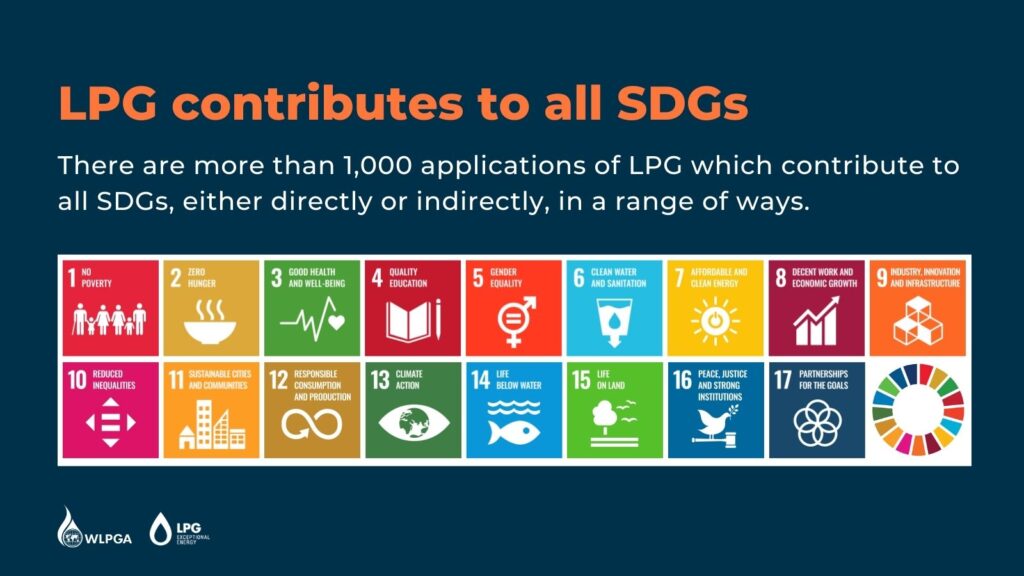‘The LPG Contribution to Keeping the SDGs on Track’ by James Rockall, CEO & Managing Director, WLPGA
 In 2015, all UN member states adopted the 2030 Agenda for Sustainable Development with, at its heart, the 17 Sustainable Development Goals (SDGs) which recognise that ending poverty and other deprivations must go hand-in-hand with strategies that improve health and education, reduce inequality, and spur economic growth – all while tackling climate change and working to preserve our oceans and forests. The multiple and interlinked global crises we are currently facing – the COVID-19 pandemic, the climate crisis, and the impacts of the war in Ukraine – are putting the very viability of achieving the SDGs by 2030 at great risk. To keep the SDGs on track, we need to focus on pathways that will not only reduce carbon emissions, but also conserve natural resources, promote health, and advance the transition to a more inclusive and just economy. LPG, and renewable LPG (rLPG), can do this and contribute to all 17 goals as part of our sustainable future.
In 2015, all UN member states adopted the 2030 Agenda for Sustainable Development with, at its heart, the 17 Sustainable Development Goals (SDGs) which recognise that ending poverty and other deprivations must go hand-in-hand with strategies that improve health and education, reduce inequality, and spur economic growth – all while tackling climate change and working to preserve our oceans and forests. The multiple and interlinked global crises we are currently facing – the COVID-19 pandemic, the climate crisis, and the impacts of the war in Ukraine – are putting the very viability of achieving the SDGs by 2030 at great risk. To keep the SDGs on track, we need to focus on pathways that will not only reduce carbon emissions, but also conserve natural resources, promote health, and advance the transition to a more inclusive and just economy. LPG, and renewable LPG (rLPG), can do this and contribute to all 17 goals as part of our sustainable future.
The LPG contribution to each of the SDGs is well documented in numerous case studies published by the WLPGA, but it is in the areas of gender equality, access to sustainable energy and combating climate change that LPG has such a powerful impact.
The world is not on track to achieve gender equality by 2030 and has been pushed further off track by the socioeconomic fallout of the pandemic. Over 100 million women aged 25-54, with small children at home, are out of the workforce globally, including the more than two million who left the labour force due to the increased pressures of unpaid care work1. The LPG industry has proven its readiness to support increasing gender equality and equity in all forms, with emphasis on educational, career, and household support. The use of LPG in household cooking reduces household air pollution that disproportionally affects women and children. Eliminating the harmful burden of unsafe cooking and providing safe energy alternatives as it applies in the home, is crucial to aid in achieving gender equality. As it relates to education, the importance of stable and affordable infrastructure to educate girls in remote and developing areas, where they otherwise might not be given the opportunity, is a key benefit of LPG over the use of traditional fuels for cooking.
Despite progress, there are still over 700 million people globally living in the dark1 and 2.6 billion, or one third of the planet, cooking with harmful and polluting fuels2. This is leading to over four million premature deaths each year2. LPG is an accessible, transportable, and cost-effective fuel, ready to meet the needs of these people who still cook, heat, and light their homes with polluting fuels. The use of LPG in the most remote areas of the world, for instance powering entire island communities, creates reliable and compatible infrastructure with renewable energies for the ongoing transition. LPG is a flexible source of energy, both in storage and application. This means that it works well in combination with renewable energy sources, while still ensuring reliable and fast access when the sun isn’t shining, and the wind isn’t blowing.
To limit global warming to 1.5°C, scientists recommend that by 2030, global emissions should be cut by 45% compared to 2010 levels. According to current national commitments however, global emissions are set to increase by almost 14% during the rest of the decade1. With many parts of the world dependent on highly polluting and inefficient energy carriers such as wood, solid and liquid fuels, we need to act now to decarbonise our energy systems. LPG is huge step forward in reducing greenhouse gas emissions, by replacing high emissions fuels like gasoline with LPG in automobiles, and solid fuels burned in traditional stoves for cooking and heating. In developed economies, LPG offers 15% lower greenhouse gas emissions than heating with fuel oil3 and can immediately contribute to reducing carbon emissions in hard-to-electrify areas. The pathway to achieving even deeper emissions reductions with LPG is now opening, as near-zero renewable LPG (rLPG) is being developed. Suitable as a drop-in fuel into existing infrastructure, rLPG can ensure that the infrastructure investments already made by consumers and energy providers need not be wasted but be repurposed, providing for a more efficient and acceptable transition.
Our future must not be seen just through the important, but narrow lens of climate change. Tomorrow’s energy systems need also to deliver on all the real challenges facing the people on our planet. Today, we stand on the precipice of a critical moment. Either we fail to deliver on our commitments to support the world’s most vulnerable, or together we re-invigorate our efforts to meet the SDGs and deliver meaningful progress for people and planet by 2030. LPG, renewable LPG, and the companies and people behind this exceptional energy, stand ready to play their role as part of the solution to our future energy challenges.
James Rockall, CEO & Managing Director, WLPGA
There are more than 1,000 applications of LPG, a clean-burning fuel, which contribute to all SDGs either directly or indirectly in a range of ways. The value of LPG is easily recognised in the context of SDG 7 focusing on affordable and clean energy, given its widespread use as a household cooking fuel. This is, however, only a small part of the story. Learn more on this page: Sustainable Development Goals

Sources:
1 https://sustainabledevelopment.un.org/content/documents/29858SG_SDG_Progress_Report_2022.pdf
3 https://www.worldliquidgas.org/about-lpg/lpg-society/emissions-climate/